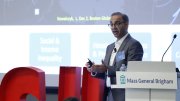A central purpose of Harvard University is to do what we can to ensure that everyone in America has a chance. Such a concept could be considered a lofty ideal with little meaning. Yet this is as important as any tradition in higher education, and ours is a distinguished history: the concept of financial aid, the initial scholarships established by President Conant, the first institution to move to need-blind admissions in the 1950s, as well as the first in the 1990s to move to need-blind assistance for international students.
However if one looks at the national picture, there is ample reason to be concerned. Seldom has the American dream looked so distant for so many. Inequality is widening; and the transmission of inequality may be increasing generation to generation, so that the gap between the life-chances in children of the fortunate and children of the less fortunate is rising. The facts are stark:
* In the United States today, a student from the top income quartile is more than six times as likely as a student from the bottom income quartile to graduate with a B.A. within five years of leaving high school.
* At selective institutions, only 10 percent come from the bottom half of the income scale. In other words, children whose families are in the lower half of the American income distribution are underrepresented by 80 percent.
* The data are less clear for professional schools, but it appears that students in these schools have even more affluent parents than those in college.
Ironically, higher educationwhich should be a force in equalizing opportunityis adding to this problem. To a degree, differences in access to higher education do point to disparities in preparation and abilitybut less, I suspect, than is commonly supposed. We can all agree that no child should be left behind, but let us also agree that every child can get ahead. We should never accept, as one observer bluntly notes, that the least bright rich kids are as likely to go to collegeand more likely to go to a good collegethan the brightest poor kids.
That is why, at Harvard, we have committed to a multifaceted approach, to send the strongest possible message to students from families of low and moderate income.
First, families with incomes of less than $40,000 will no longer be expected to contribute to the cost of attending Harvard for their children. Families with incomes of less than $60,000 will also see their contributions reduced.
Representatives from our Admissions and Financial Aid Offices are visiting these families on recruiting trips across the country. We're taking a hard look at the distorting imbalance of the application process itself. We are seeing fee waiver requests from early action applicants up 70 percent over last year.
Second, we have created an intensive summer program on the Harvard campusthe Crimson Summer Academyfor academically talented high school students from disadvantaged backgrounds in the greater Boston area.
And third, the wider University is playing its part in three key areas. We have established a Presidential Scholars program to fund outstanding graduate students who come to Harvard to pursue careers in public service. Our Graduate School of Education has a long tradition of supporting outstanding research in learningresulting in such innovations as Sesame Street in the 1960s and pointing toward an increasing role in K-12 education and the world of practice. And our Public Education Leadership Project teams faculty from our Business and Education Schools in a program that works with top management from 11 of the nation's top urban schools.
At the start of this New Year, we all have important parts to play in ensuring continued commitment to access. I have been impressed by the dedication of our own undergraduates working with our Financial Aid Office. Since the fall, these students have been looking across Americacalling, e-mailing and visiting the most talented students from economically disadvantaged backgrounds.
They are telling them Harvard is not an impossible dream and are making sure they get connected to the college admissions process. Many student recruiters come from similar backgrounds and their stories brought home to me just how inhospitable some of our campuses can be, simply because of varying financial means.
Restoring education to its proper role as a pathway to equal opportunity and excellence in our society is an absolute and continuing priorityboth for Harvard and in national policy. We have made a start, but we have a long way to go.
I wish you the best in this New Year.





